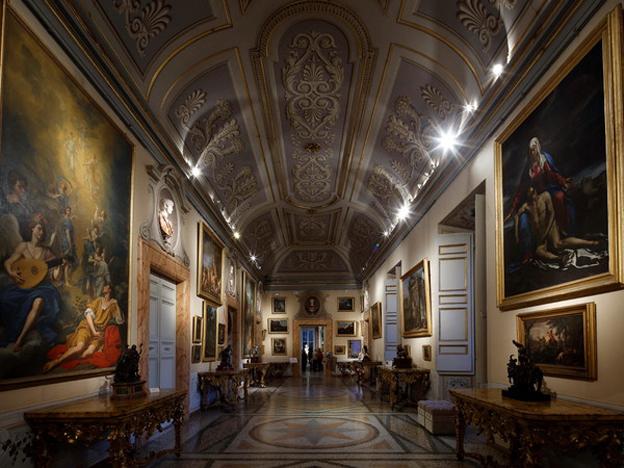[Photo: Galleria Corsini, Rome]
Add two more palaces-museums to your already long list of things to see in Rome: Palazzo Barberini and Galleria Corsini, which together form the Galleria Nazionale d'Arte Antica (National Gallery of Ancient Art), are set to undergo a series of changes meant to make the sites more accessible and attractive to the general public.
Palazzo Barberini, a classic example of a Baroque palace, is the work of some of the most important architects of the 17th century, namely Carlo Maderno, Gian Lorenzo Bernini and Francesco Borromini. In 1625, two years after being elected pope with the name of Urban VIII, Maffeo Barberini commissioned Maderno with the renovation of a villa he bought for his grandchildren on the Quirinal Hill. Maderno created a structure with open wings framing a vast yard, with rare plants, secret courtyards and Italian-style gardens. The heart of the palace is the majestic reception hall frescoed by Pietro da Cortona.
Palazzo Barberini is accessed from Via delle Quattro Fontane.
The history of Palazzo Corsini begins in 1511 with the construction of a building on the plots of land of Via della Lungara. The original building was modified between 1659 and 1689, when it became the residence of Christina, Queen of Sweden, who moved to Rome in 1655 after converting to Catholicism. Christina was a cultured woman with a passion for the arts and used the palace as a gathering point for the city’s intellectuals and artists. She ordered a restructuring of the palace to house a collection of statues on the ground floor and a picture gallery on the main floor.
The building was acquired by the Corsini family when Lorenzo Corsini became pope in 1736 with the name of Clement XII. The rich Florentine family needed a Roman residence that would be grand enough to display the new prestigious status, therefore it commissioned architect Ferdinando Fuga to restructure the existing parts of the building and to expand it.
Galleria Corsini became the first national gallery of Italy, when, in 1883, its collections were donated to the newly-formed Kingdom of Italy. Palazzo Barberini became a museum in 1953 when it joined Galleria Corsini as the seat of the Galleria Nazionale d’Arte Antica.
Scheduled improvements to the museums include a re-arrangement of the collections, a multi-media approach, themed itineraries, and international exchanges – all meant to highlight the “fascinating story of how art has been looked at, collected, disseminated and reinvented from the times of Urban VIII (first half of the 17th century) to those of Neri Corsini (second mid-18th century) to the present day,” said gallery’s director Flaminia Gennari Sartori.
The collections of Palazzo Barberini and Galleria Corsini includes such masterpieces as the Annunciation by Filippo Lippi, Judith and Holofernes by Caravaggio and Raphael's La Fornarina, the Allegory of Divine Providence fresco by Pietro da Cortona, and a bust of Urbano VIII by Bernini; as well as an extraordinary representation of works from the 17th and 18th centuries from the collections of the Barberini and Corsini families.
For more information and to plan your visit, see the Galleria Nazionale d’Arte Antica website.







